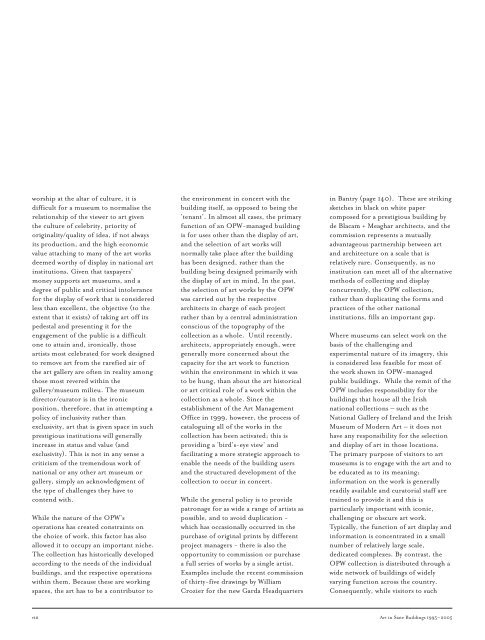Art in State Buildings 1995 to 2005 - The Office of Public Works
Art in State Buildings 1995 to 2005 - The Office of Public Works
Art in State Buildings 1995 to 2005 - The Office of Public Works
Create successful ePaper yourself
Turn your PDF publications into a flip-book with our unique Google optimized e-Paper software.
worship at the altar <strong>of</strong> culture, it is<br />
difficult for a museum <strong>to</strong> normalise the<br />
relationship <strong>of</strong> the viewer <strong>to</strong> art given<br />
the culture <strong>of</strong> celebrity, priority <strong>of</strong><br />
orig<strong>in</strong>ality/quality <strong>of</strong> idea, if not always<br />
its production, and the high economic<br />
value attach<strong>in</strong>g <strong>to</strong> many <strong>of</strong> the art works<br />
deemed worthy <strong>of</strong> display <strong>in</strong> national art<br />
<strong>in</strong>stitutions. Given that taxpayers’<br />
money supports art museums, and a<br />
degree <strong>of</strong> public and critical <strong>in</strong><strong>to</strong>lerance<br />
for the display <strong>of</strong> work that is considered<br />
less than excellent, the objective (<strong>to</strong> the<br />
extent that it exists) <strong>of</strong> tak<strong>in</strong>g art <strong>of</strong>f its<br />
pedestal and present<strong>in</strong>g it for the<br />
engagement <strong>of</strong> the public is a difficult<br />
one <strong>to</strong> atta<strong>in</strong> and, ironically, those<br />
artists most celebrated for work designed<br />
<strong>to</strong> remove art from the rarefied air <strong>of</strong><br />
the art gallery are <strong>of</strong>ten <strong>in</strong> reality among<br />
those most revered with<strong>in</strong> the<br />
gallery/museum milieu. <strong>The</strong> museum<br />
direc<strong>to</strong>r/cura<strong>to</strong>r is <strong>in</strong> the ironic<br />
position, therefore, that <strong>in</strong> attempt<strong>in</strong>g a<br />
policy <strong>of</strong> <strong>in</strong>clusivity rather than<br />
exclusivity, art that is given space <strong>in</strong> such<br />
prestigious <strong>in</strong>stitutions will generally<br />
<strong>in</strong>crease <strong>in</strong> status and value (and<br />
exclusivity). This is not <strong>in</strong> any sense a<br />
criticism <strong>of</strong> the tremendous work <strong>of</strong><br />
national or any other art museum or<br />
gallery, simply an acknowledgment <strong>of</strong><br />
the type <strong>of</strong> challenges they have <strong>to</strong><br />
contend with.<br />
While the nature <strong>of</strong> the OPW’s<br />
operations has created constra<strong>in</strong>ts on<br />
the choice <strong>of</strong> work, this fac<strong>to</strong>r has also<br />
allowed it <strong>to</strong> occupy an important niche.<br />
<strong>The</strong> collection has his<strong>to</strong>rically developed<br />
accord<strong>in</strong>g <strong>to</strong> the needs <strong>of</strong> the <strong>in</strong>dividual<br />
build<strong>in</strong>gs, and the respective operations<br />
with<strong>in</strong> them. Because these are work<strong>in</strong>g<br />
spaces, the art has <strong>to</strong> be a contribu<strong>to</strong>r <strong>to</strong><br />
the environment <strong>in</strong> concert with the<br />
build<strong>in</strong>g itself, as opposed <strong>to</strong> be<strong>in</strong>g the<br />
‘tenant’. In almost all cases, the primary<br />
function <strong>of</strong> an OPW-managed build<strong>in</strong>g<br />
is for uses other than the display <strong>of</strong> art,<br />
and the selection <strong>of</strong> art works will<br />
normally take place after the build<strong>in</strong>g<br />
has been designed, rather than the<br />
build<strong>in</strong>g be<strong>in</strong>g designed primarily with<br />
the display <strong>of</strong> art <strong>in</strong> m<strong>in</strong>d. In the past,<br />
the selection <strong>of</strong> art works by the OPW<br />
was carried out by the respective<br />
architects <strong>in</strong> charge <strong>of</strong> each project<br />
rather than by a central adm<strong>in</strong>istration<br />
conscious <strong>of</strong> the <strong>to</strong>pography <strong>of</strong> the<br />
collection as a whole. Until recently,<br />
architects, appropriately enough, were<br />
generally more concerned about the<br />
capacity for the art work <strong>to</strong> function<br />
with<strong>in</strong> the environment <strong>in</strong> which it was<br />
<strong>to</strong> be hung, than about the art his<strong>to</strong>rical<br />
or art critical role <strong>of</strong> a work with<strong>in</strong> the<br />
collection as a whole. S<strong>in</strong>ce the<br />
establishment <strong>of</strong> the <strong>Art</strong> Management<br />
<strong>Office</strong> <strong>in</strong> 1999, however, the process <strong>of</strong><br />
catalogu<strong>in</strong>g all <strong>of</strong> the works <strong>in</strong> the<br />
collection has been activated; this is<br />
provid<strong>in</strong>g a ‘bird’s-eye view’ and<br />
facilitat<strong>in</strong>g a more strategic approach <strong>to</strong><br />
enable the needs <strong>of</strong> the build<strong>in</strong>g users<br />
and the structured development <strong>of</strong> the<br />
collection <strong>to</strong> occur <strong>in</strong> concert.<br />
While the general policy is <strong>to</strong> provide<br />
patronage for as wide a range <strong>of</strong> artists as<br />
possible, and <strong>to</strong> avoid duplication -<br />
which has occasionally occurred <strong>in</strong> the<br />
purchase <strong>of</strong> orig<strong>in</strong>al pr<strong>in</strong>ts by different<br />
project managers - there is also the<br />
opportunity <strong>to</strong> commission or purchase<br />
a full series <strong>of</strong> works by a s<strong>in</strong>gle artist.<br />
Examples <strong>in</strong>clude the recent commission<br />
<strong>of</strong> thirty-five draw<strong>in</strong>gs by William<br />
Crozier for the new Garda Headquarters<br />
<strong>in</strong> Bantry (page 140). <strong>The</strong>se are strik<strong>in</strong>g<br />
sketches <strong>in</strong> black on white paper<br />
composed for a prestigious build<strong>in</strong>g by<br />
de Blacam + Meaghar architects, and the<br />
commission represents a mutually<br />
advantageous partnership between art<br />
and architecture on a scale that is<br />
relatively rare. Consequently, as no<br />
<strong>in</strong>stitution can meet all <strong>of</strong> the alternative<br />
methods <strong>of</strong> collect<strong>in</strong>g and display<br />
concurrently, the OPW collection,<br />
rather than duplicat<strong>in</strong>g the forms and<br />
practices <strong>of</strong> the other national<br />
<strong>in</strong>stitutions, fills an important gap.<br />
Where museums can select work on the<br />
basis <strong>of</strong> the challeng<strong>in</strong>g and<br />
experimental nature <strong>of</strong> its imagery, this<br />
is considered less feasible for most <strong>of</strong><br />
the work shown <strong>in</strong> OPW-managed<br />
public build<strong>in</strong>gs. While the remit <strong>of</strong> the<br />
OPW <strong>in</strong>cludes responsibility for the<br />
build<strong>in</strong>gs that house all the Irish<br />
national collections – such as the<br />
National Gallery <strong>of</strong> Ireland and the Irish<br />
Museum <strong>of</strong> Modern <strong>Art</strong> – it does not<br />
have any responsibility for the selection<br />
and display <strong>of</strong> art <strong>in</strong> those locations.<br />
<strong>The</strong> primary purpose <strong>of</strong> visi<strong>to</strong>rs <strong>to</strong> art<br />
museums is <strong>to</strong> engage with the art and <strong>to</strong><br />
be educated as <strong>to</strong> its mean<strong>in</strong>g;<br />
<strong>in</strong>formation on the work is generally<br />
readily available and cura<strong>to</strong>rial staff are<br />
tra<strong>in</strong>ed <strong>to</strong> provide it and this is<br />
particularly important with iconic,<br />
challeng<strong>in</strong>g or obscure art work.<br />
Typically, the function <strong>of</strong> art display and<br />
<strong>in</strong>formation is concentrated <strong>in</strong> a small<br />
number <strong>of</strong> relatively large scale,<br />
dedicated complexes. By contrast, the<br />
OPW collection is distributed through a<br />
wide network <strong>of</strong> build<strong>in</strong>gs <strong>of</strong> widely<br />
vary<strong>in</strong>g function across the country.<br />
Consequently, while visi<strong>to</strong>rs <strong>to</strong> such<br />
viii <strong>Art</strong> <strong>in</strong> <strong>State</strong> Build<strong>in</strong>gs <strong>1995</strong>–<strong>2005</strong>

















